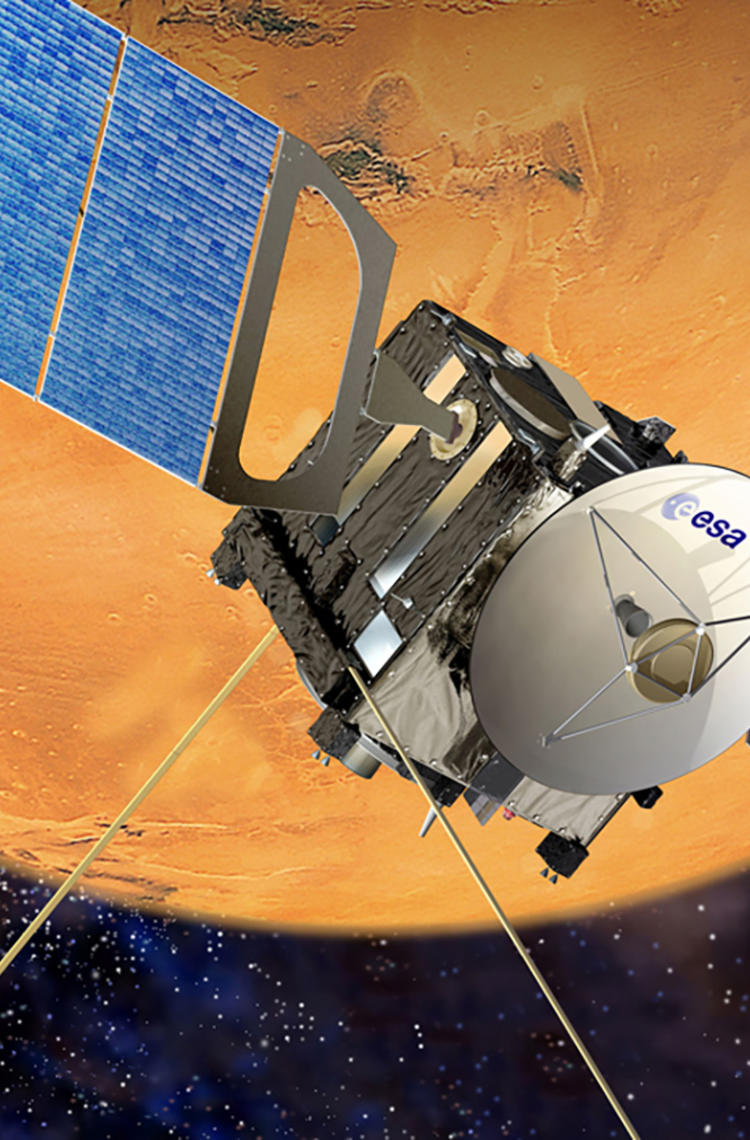Exploring the Red Planet
Ever since Galileo first observed Mars through a telescope in 1610, scientists have been increasingly drawn to the planet. Its geological and climatic similarities to Earth have made Mars the focus of some of the most ambitious exploration programmes in the Solar System.
Building on extensive experience in such complex interplanetary missions as the first European probes to Mars, Venus, Jupiter and Mercury – along with Rosetta, the first spacecraft to land on a comet – Airbus is actively working on a number of Mars missions to be launched in the coming decade.
Our Mars story started at the turn of the century with the Mars Express mission, which was launched in 2003 and still continues to provide scientists with valuable data. Looking to the future, Airbus is playing a leading role in the ExoMars and Mars Sample Return missions.


ExoMars rover: Europe’s first rover mission to the Red Planet
The rover will search for evidence of past or present life and help us better understand the history of water on Mars. Built by Airbus in Stevenage, UK, it is named after Rosalind Franklin, a famous British scientist.
With its autonomous navigation system, it will travel more quickly than by being driven remotely from Earth. Its drill can take samples from as deep as two metres below ground and its 3D panoramic camera can provide data on the surface texture and atmosphere.
Bringing Mars back to Earth: the Earth return orbiter
Mars Sample Return is a set of three separately launched missions that together will achieve the goal of returning Mars samples to Earth. Once launched,, the Earth Return Orbiter (ERO) will begin a five-year mission to Mars, acting as a communications relay with the surface missions, performing a rendezvous with the orbiting samples and bringing them safely back to Earth.
With a mass of seven tonnes when it begins its round-trip mission from Earth, the seven-metre-tall spacecraft will have solar arrays covering 144 sq. metres and spanning more than 40 metres – among the largest ever built.

For its interplanetary journey, ERO will benefit from the autonomous rendezvous and docking capabilities that Airbus has developed over decades in optical space navigation.
Once ERO has captured the metal ball containing the Martian surface material in orbit around Mars, the spacecraft will then head back to the vicinity of Earth where the samples will be released recovery.
As prime contractor for ERO under the responsibility of the European Space Agency, Airbus will have overall responsibility for this orbiter’s mission. The spacecraft’s development is centred at Airbus’ Toulouse, France, while mission analysis is performed at the company’s UK site in Stevenage.



The exceptional odyssey of Mars Express
Mars Express was the European Space Agency's first planetary mission when it was launched in 2003. Originally designed for a mission duration of one Martian year (or 687 Earth days), the orbiter is now one of the oldest spacecraft in operation beyond Earth.
Its instruments have provided fundamental information about the topology and composition of the planet's surface, subsurface and atmosphere.
The latest space exploration news
In the spotlight
-

Airbus ships fourth European Service Module for Artemis IV
Press Release
Space
Fourth European Service Module (ESM-4) is ready to leave Airbus’ facilities in Bremen, Germany, and be shipped to NASA’s Kennedy Space Center, Florida, USA -

Airbus to design and build ESA’s ExoMars rover lander platform
Press Release
Space
-

Keeping the lights on for the lunar Gateway HALO module
Web Story
Space
-

Orion’s European Service Module 3, the backbone of return to the Moon
Web Story
Space
-

The Rosetta odyssey: first ever comet-chaser
Web Story
Space







